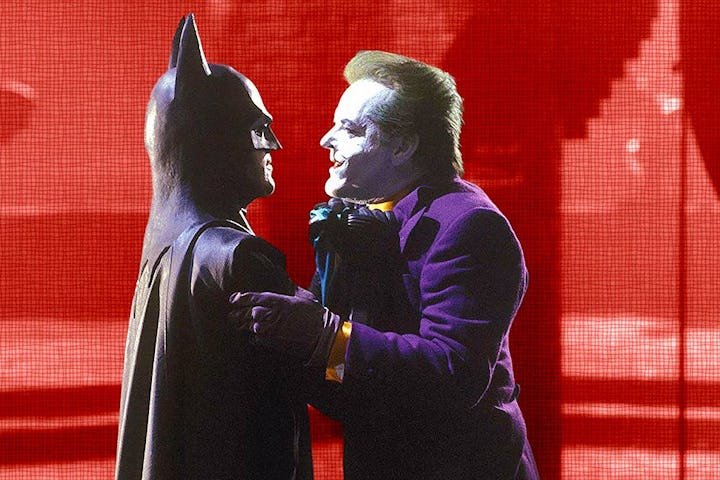34 Years Later, Michael Keaton’s First Batman Movie Is Still The Best
Let’s get nuts.

Holy passage of time! Brace yourself, fellow olds, as of June 23, 2023, the best Batman movie of all time is now 34 years old. Since then, there have been five big screen Bat-men, some reviled (Clooney), some beloved (Bale) and, I imagine by the time I’m dead, there will be at least twenty or so more. With the recent release of The Flash, we’re also oddly back to Michael Keaton, again. (Too bad he can’t just have his own new movie, right?) But why, over three decades later, is the Michael Keaton/Tim Burton 1989 Batman so good? The answer is mostly this: It could never be made today.
These days, we think of the Christian Bale movies (or Pattison) as being “dark,” but when Batman came out in 1989 it was way darker and stranger than anything moviegoers had seen in the superhero genre. To put it another way, as great as The Dark Knight was in 2008, it’s not like that movie took a ton of risks, from a creative standpoint. The Dark Knight, is, in almost every single way, a film that panders directly to what movie audiences want out of Batman: grittiness, “realism,” fights with the Joker, and a sense of weightiness that is truly undeserved of a story revolving around a man who dresses up as Bat to fight crime. In a sense, The Dark Knight is the hard-hitting documentary version of ‘89’s Batman. And that’s because, in June 1989, no one really knew what they wanted out of a superhero movie. The genre, as we know it, practically didn’t exist.
Let’s start with the weird opening credits to Batman. The camera is taking us around the curves of — what? — a cave? The contours of stone-age spacecraft? An ancient castle? Superman’s Fortress of Solitude with the lights turned off? Nope! It’s just a giant carved-out Bat-symbol, which, doesn’t really play a role in the film. This gothic, super-confident opening title sequence, thrillingly scored by Danny Elfman’s memorable “The Batman Theme,” pretty much sets the tone for what you’re about to watch. The giant stone-carved Bat-symbol is emblematic of the impressionistic style of the entire film. In some ways, you could argue that Tim Burton didn’t just turn a comic book into life. Instead, it’s like Tim Burton discovered 16th-century gothic tapestries that happened to depict Batman and then decided to make a movie out of those.
Famously, the film deviates from established Batman origin stories right off the…err…bat. Jack Nicholson’s iconic Joker is accidentally created by Batman in the opening of the film, and he’s not a criminal named Joe Cool, but instead, a mid-level gangster named Jack Napier. Nothing about Jack’s transformation into the Joker makes sense. In fact, in 2008, Christopher Nolan was smart enough to avoid “explaining” Heath Ledger’s Joker at all. And that’s because it’s impossible to take the Joker seriously if you’re trying to do a movie.
This is why it’s totally brilliant that both Burton and Nicholson do not try to take the Joker seriously. This is perhaps blasphemous, but I actually prefer Jack Nicholson’s Joker to all other versions of the character, mostly because he does what no other actor has managed to do with the part: He’s both funny and dangerous at the same time. We’ll get to Michael Keaton in a second, but let’s face it, Nicholson gets some of the best lines in this film: “A little song, a little dance, Batman’s head on a lance,” or “This town needs an enema!” or “You…are my number one…a guy!” and finally, the immortal…”You ever dance with the devil in the pale moonlight?”
This guy is still the best.
The fact this movie is so quotable is part of what makes it so excellent. Remember when Keaton — as Bruce Wayne — says “Wanna get nuts! Let’s get nuts!” Come on. This is classic stuff. Say what you will about the relative cultural importance of comic books, but most people can’t quote directly from their pages. However, we can, and often do, quote from comic book movies. Which, is again, why the ‘89 Batman endures.
Of course, it’s impossible to talk about the film without talking about my favorite big-screen Batman of all time. Okay, in fairness, when I was a kid, my favorite big-screen Batman was Adam West, but let’s face it, the 1966 film is just a giant episode of the TV show, meaning that Michael Keaton is truly the best Bat of the silver screen. Why? Well, in order to be a good Batman you have to be a good Bruce Wayne. And, for my money, in order to be a good Bruce Wayne, you have to be a likable Bruce Wayne. Arguably, both Christian Bale and Ben Affleck are believable and realistic Bruce Waynes. They’re tortured. They put up a weird front to protect their Batman-ness. But, to me, Michael Keaton approached Bruce Wayne the most creatively. Instead of acting like an aloof millionaire playboy, Keaton played Bruce Wayne as a goofball. The moment when he tries to tell Kim Basinger “I’m Batman,” is literally the entire movie. He isn’t doing it in Batman's voice, he’s doing it in a real voice. The voice of a guy we all relate to, too.
With Michael Keaton, regular guys were allowed to think of themselves as Batman. And in doing so, we could transport ourselves into a bizarre kaleidoscope of a movie that was half comic book and half trippy acid dream. This effect and the movie have never been topped. We may have danced with other Batmen since 1989, but never in the pale moonlight.
Batman (1989) is streaming on MAX.
*Editor’s note: A previous version of this article appeared on Fatherly in 2019.
This article was originally published on